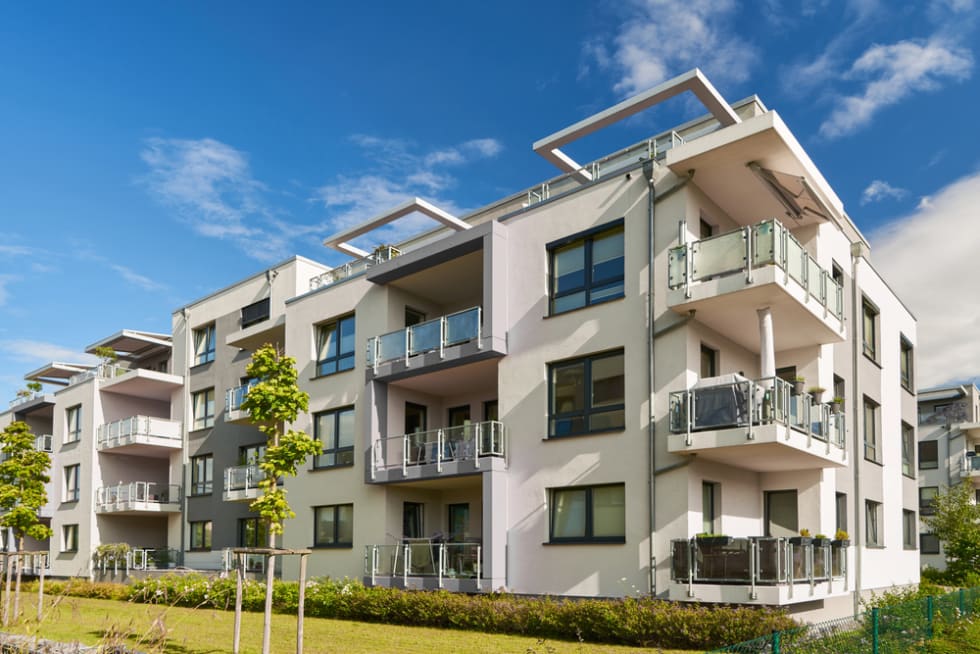South Bank at Quarry Trails
- 94 units available
- Studio • 1 bed • 2 bed • 3 bed
- Amenities
In unit laundry, Patio / balcony, Granite counters, Pet friendly, Stainless steel, Walk in closets + more

Whether you're a novice or a seasoned apartment hunting pro, realizing how many options are available can feel overwhelming. There are tons of places to consider, from walkups to condos and garden apartments.
We broke down all the different types of apartments to give you an idea of what to expect and how to make the best choice for you.
Before you get started, keep in mind how we categorized each apartment type. We broke everything down into three main categories:
As you read through everything, think about which aspects are the most important to you. For example, you may not care that much about the building type, but the amenities and layout you choose could be your non-negotiables.
The apartment size and layout are crucial parts of apartment hunting, especially if you're looking for a roommate. Here's what to know about each apartment type.
A studio apartment is a small, self-contained apartment, sometimes called efficiency apartments or bachelor apartments. The layout usually includes one oversized room used as a bedroom, a living room, and sometimes a kitchen. Some studio apartments have a separate galley kitchen that resembles a small hallway.
While it can be challenging to decorate a studio apartment if you crave dimension and space, they are usually cheaper and easier to keep clean. In addition, you can create more division in your studio apartment by using curtains as faux walls, bookcases, and even plants to designate different areas.
Lofts are residential spaces in former industrial buildings turned into modern apartments. They traditionally feature high ceilings with exposed pipes and brick or cement walls. Lofts may have a continuous, one-room layout, but they are larger than studio apartments. Others have more than one level or a loft area that doubles as a bedroom.
Although most lofts are industrial, you can also rent a "soft loft." These lofts mimic the style and appeal of lofts while less rugged and industrial. These buildings are usually renovated residential buildings.
As the name implies, a one-bedroom apartment is an apartment with a single bedroom. Depending on the area they're located in, a room without a closet isn't considered a bedroom. In other locations, the bedroom only needs a window and a door. Minimum square footage is usually required to be legally considered a one-bedroom.
You'll probably find cities with a competitive rental market, like New York City, largely deviate from these rules. For example, it's not uncommon to find basement apartments without windows or closets but are rented at a lower price.
If you're looking to move to the Northeast, you may see Junior 4 coops or a Jr4 listed for rent. You'll find a bedroom, living room, kitchen, and small dining area. The dining alcoves are usually transformed into small dens or offices, especially during the rise of remote work. Junior 4s are often found in "pre-war" buildings or apartments constructed before World War II.
A two-bedroom apartment is a unit with two separate and distinctive bedrooms. Each room should have a window, space for a bed, and a closet, though the closet rule could vary depending on your location.
Two-bedroom apartments are an easy choice for roommates, but some cities with older buildings, like New York City and Boston, make it more difficult. It's common to find an apartment where one bedroom is larger than the other. Before looking, decide which roommate will take the smaller room at a reduced rent or additional incentive.
Shotgun-style apartments are typical in urban areas with older tenant buildings or brownstones divided into smaller units. Shotgun apartments, sometimes called railroad-style or thorough-through apartments, have rooms lined up in a row or an L shape.
If you rent a shotgun-style apartment, you will probably need to walk from your bedroom through the living room and kitchen to get to a bathroom or front door. Shotgun apartments with two bedrooms usually have bedrooms on each end of the apartment.
Condominiums, or condos, are housing or residential complexes with separate units. While they look like regular apartments, individuals own them. So, when you rent a condo, you're signing a lease directly with the owner. Individual ownership makes condos more personable and may have completely different appliances and countertops than other condos in the same building.
Condominium buildings have HOAs with additional fees to pay for the upkeep of shared space or structures, like a roof. A condo will also have a board or a group of owners who help facilitate the voting process to make building-related decisions or community rules.
Penthouse apartments are luxury units located on the top floor of apartment buildings. They typically come with dazzling views, vaulted ceilings, and expansive windows. Traditionally, penthouse apartments took up the entire top floor of a building. However, it's not uncommon to see every unit on the top floor marketed as a high-end penthouse apartment in some cities.
Walkup apartments are situated inside several stories without elevators. Walkups are usually just a few floors high, but you may find apartments in dense, urban cities that advertise five and six-floor walkups. It's challenging to move into a walkup building when you live on a higher floor. However, rents are usually cheaper.
Garden apartments are multi-unit, mid-rise buildings with outdoor space. They're usually up to three stories high, and despite the name, they don't necessarily open up to green space. Instead, tenants typically share open spaces with other renters, like lawns, wooded areas, or gardens.
Garden apartments aren't exclusive to rural or suburban areas. Some cities list garden apartments as ground floor units or basement apartments with direct access to outdoor space.

Now that you have a sense of the layout and types of apartments available, it's time to check out the building type.
Low-rise apartment buildings are usually up to four stories high with no elevator. Some people call these "walkups" because you'll need to access the stairs to get to your apartment. You may also hear these referred to as "garden-style apartments” if green space, lawns, or wooded areas surround the property.
Mid-rise apartments are taller than low-rise options, with five to twelve floors, although that number can vary depending on the location. Most mid-rise buildings will have an elevator, although it's not out of the question to find walkup midrises with only stair access in areas like New York City.
High-rise buildings are those that are no more than 12 floors high. These buildings are generally in urban areas and often become part of the larger skyline and landscape. Although these are strictly residential towers, a high-rise can also be an office or mixed-use space.
A townhouse is a multi-floor home with at least one wall adjacent to another townhouse or building. Townhouses have private entrances but may also share common spaces with other tenants. In addition, some townhouse rentals have their own small, enclosed outdoor space and balconies.
Townhouses are similar to row houses. But the term row house is usually reserved for older residential buildings in cities like New York and Boston.
Duplexes are often confused with twin homes because they are essentially two-family homes. The layout includes two units in a single building, either positioned side by side or on top of one another. Duplexes also share a common wall, although they have separate, private entrances.
4plex apartments, also called quadplexes, are multi-family homes with four separate living spaces. They also have private entrances for each renter. 4 plex units may sit on top of each other, next to each other, or a combination of the two.

Apartment amenities are unique or nonessential features or services offered to renters and are essential for the apartment hunting process. Here's what to know about amenities and how to choose the right fit for you.
Fitness centers are a popular apartment amenity and help trim down expenses. You won't need a gym membership and can stay on-site to get fit or meet your neighbors. Of course, not all on-site fitness centers are worth your time. Make sure your apartment gym offers the right equipment and accessories.
Laundry is often a coveted amenity in cities like Boston, especially if it's located inside your apartment and not in a common area. Make sure to check your lease terms. Some washers and dryers are not covered for repairs, and up to the renter to fix them if they break.
Common areas with grills, fire pits, and rooftop decks are great for renters who love to entertain. Find out if there are any quiet hours, rules, or restrictions for hosting a gathering or hanging out with the neighbors until the late-night hours.
A business center is a big perk in an apartment complex if you work remotely. Look for shared desks, free WiFi, and small conference rooms.
Swimming pools are the norm in Dallas, Atlanta, and Los Angeles but are less common in the Northeast. An on-site sauna is an added perk for relaxing after work.
Covered parking included in your lease reduces time, stress, and expenses. Some apartment complexes have waitlists for parking or charge additional fees, while others include two free dedicated spaces per unit, plus a parking section for guests.
The convenience and safety of front door staff and on-site security systems are invaluable, as you can come home with peace of mind and feel safe in your own space. But door staff usually sign for packages while you're at work and announce guests.
Furnished apartments aren't as standard as unfurnished options, but they're convenient for short-term or transient renters. For example, if you're new to the area or plan to move in a year, consider a furnished apartment.
These apartments are more expensive than traditional options, but the tradeoff is probably worth it. They save the time and expense of outfitting your apartment from scratch.
With so many different types of apartments to choose from, there's an option ideal for everyone. So get started finding your perfect place with Apartment List by taking our quiz.

In unit laundry, Patio / balcony, Granite counters, Pet friendly, Stainless steel, Walk in closets + more
In unit laundry, Granite counters, Hardwood floors, Dishwasher, Pet friendly, 24hr maintenance + more